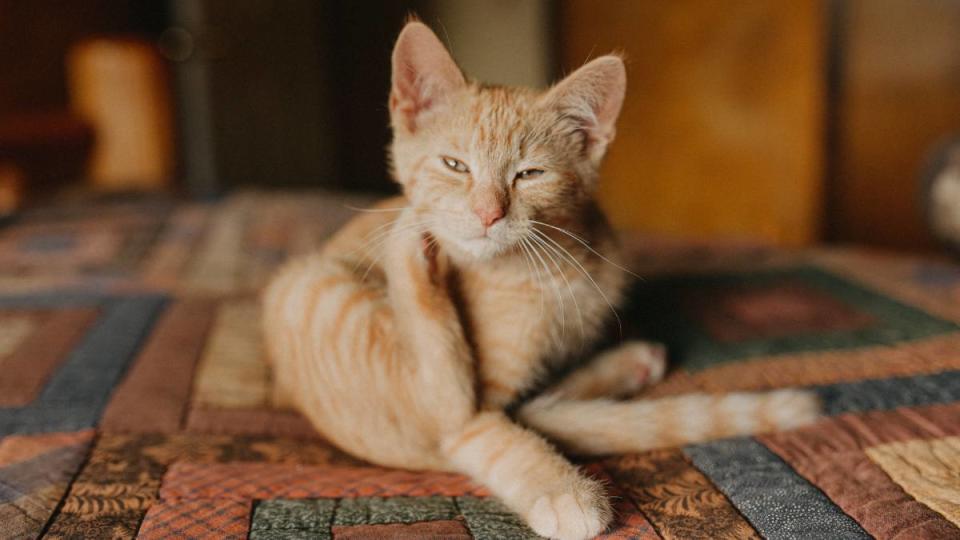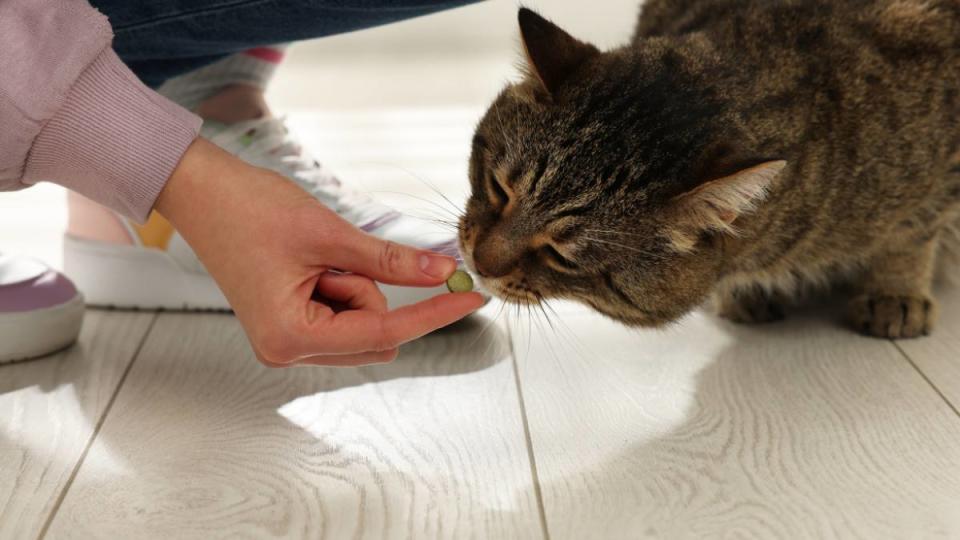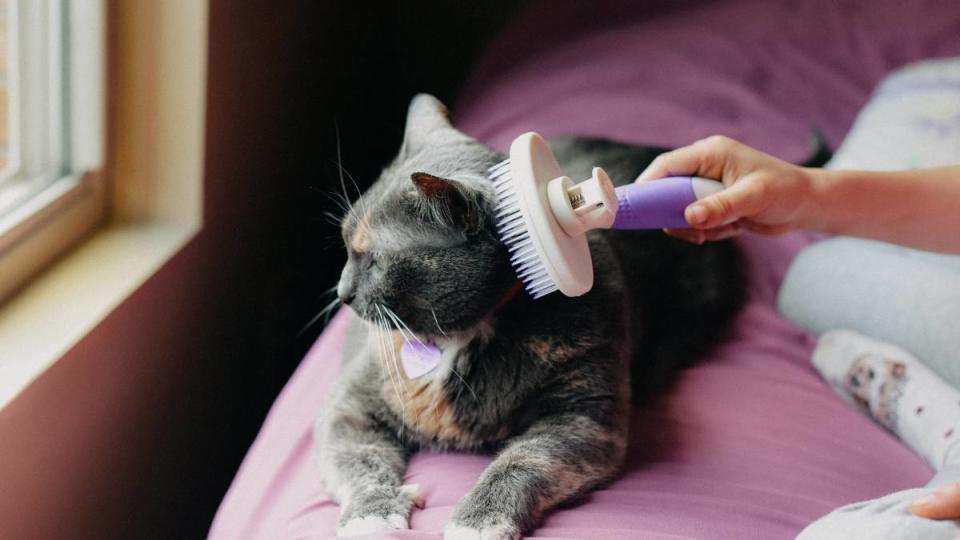*This* Vet-Recommended Kitchen Staple Helps Rid Your Kitten of Fleas
Have you wondered if your kitten is scratching more than they should be? Did you notice something dark and tiny jumping from their fur? You might just have a case of fleas on your hand — even if your kitten isn’t going outside because they can hitch a ride on humans just as easily. Unfortunately, it’s not something you can ignore. According to Jacqueline Brister, DVM, a veterinarian and contributor for Embrace Pet Insurance, “flea infestations rarely get better, and they almost always get worse.” This is what you need to know about how to get rid of fleas on kittens.
How to tell if your kitten has fleas:
The most common signs your kitten has fleas, according to vets:
Scratching and itching: Fleas cause irritation, leading to frequent scratching and itching. If you notice your kitten scratching excessively, especially around the neck, head and base of the tail, it could be a sign of fleas, says Dr. Brister.
Red or inflamed skin: Flea bites can cause redness and inflammation on your kitten's skin. Check for any signs of irritation or small red bumps.
Visible fleas or flea dirt: Part the fur on your kitten's back and check for tiny, fast-moving insects or dark, pepper-like specks. Flea dirt is actually flea feces and looks like small black or brown particles, says Dr. Brister. You can use a fine-toothed comb to comb through your kitten's fur and check for these.
Restlessness: If your kitten seems restless or is constantly grooming itself, she might be trying to alleviate the discomfort caused by fleas.
Hair loss: Flea bites can lead to hair loss, especially if the infestation is severe. Check for any patches of thinning or missing fur, says Dr. Brister.
Pale gums: In extreme cases of flea infestations, kittens may develop anemia. Check your kitten's gums — if they appear pale, it could be a sign of anemia, and you should seek veterinary attention immediately.
Why you want to get rid of fleas on kittens fast

Fleas are more than just a nuisance, according to Michelle Dulake, DVM, a veterinarian and the founder of Fera Pet Organics, they’re “nasty pests that can cause our kitten to develop health problems.” In addition to irritation and scratching, this can include:
Anemia: Fleas feed on blood, so anemia, which means a kitten doesn’t have enough red blood cells, is common. At first, you’ll notice weakness, lethargys and pale gums, but that’s not all. “Kittens can lose so much blood from flea bites that they might die,” explains Dr. Brister.
Transmission of diseases: Fleas can transmit various diseases and parasites to kittens, but the most noteworthy of them is tapeworms. When a kitten ingests an infected flea during grooming, Dr. Dulake says, it can lead to the development of tapeworms in the digestive tract.
Flea Allergy Dermatitis (FAD): “Some kittens may be hypersensitive to flea saliva, leading to an allergic reaction known as flea allergy dermatitis,” Dr. Dulake states. “FAD can cause severe itching, hair loss and skin inflammation.”
Secondary infections: Scratching and biting at flea bites can break the skin, which just like with humans, creates entry points for bacteria. This can lead to secondary bacterial infections that may require veterinary attention.
Behavioral changes: The constant itching and discomfort from fleas can cause behavioral changes in kittens — they may become irritable or anxious, or exhibit changes in grooming habits.
Stunted growth: “In severe cases of flea infestations, the constant discomfort, irritation and potential health issues can impact a kitten's overall well-being and may result in stunted growth,” Dr. Dulake says.
Luckily, fleas rarely cause harm to humans. We don’t have as much hair as animals do, which they rely on to reproduce.
How do you get rid of fleas on kittens?
Before you do anything else, Dr. Dulake advises you to “call your veterinarian to discuss a treatment plan, as most kittens are smaller in weight than adult cats and need extra attention.” Use the below from Dr. Brister as a general roadmap and conversation starter with the doctor.
How to get rid of fleas on kittens when they are 4+ weeks and 2+ pounds
Products with nitenpyram, like Capstar by Elanco (Buy on Amazon. $31.33), start killing adult fleas on the cat within 30 minutes. These products don’t work on fleas in the environment or flea eggs, and they only work for about 24 hours, so a more long-term solution, like a monthly preventative that kills adults and destroys the larvae or eggs, is needed. However, this is a great option for very young kittens.
How to get rid of fleas on kittens when they are 8+ weeks and 1.5+ pounds
Catego by Ceva (Buy on Amazon, $36.56) contains dinotefuran, fipronil, and pyriproxyfen. It is a monthly topical product that reportedly kills fleas within 2-3 hours. It is safe for kittens older than 8 weeks of age and bigger than 1.5 pounds.

How to get rid of fleas on kittens when they are 8+ weeks and 1.8+ pounds
Cheristin by Elanco (Buy on Amazon, $90.00) contains spinetoram and is a monthly topical product that starts killing fleas within 30 minutes. It is safe for cats weighing more than 1.8 pounds that are older than 8 weeks of age.
How to get rid of fleas on kittens when they are 8+ weeks and 2+ pounds
Vectra by Ceva (Buy on Amazon, $57.50) contains dinotefuran and pyriproxyfen. It is a monthly topical that kills fleas within 6 hours. It is safe for kittens older than 8 weeks of age that weigh more than 2 pounds.
How to get rid of fleas on kittens when they are 8-9+ weeks and 2+ pounds
Products that contain imidacloprid, like Advantage Multi by Bayer (Buy on Chewy, $133.84), kill fleas within about 12 hours, and any re-infesting environmental fleas within 2 hours. It also kills flea larvae. Depending on the product, it is safe for kittens 8-9 weeks and over 2 pounds.
How to get rid of fleas on kittens when they are 14+ weeks and 4+ pounds
Products with spinosad like Comfortis by Elanco (Buy on Amazon, $108.99) begin killing fleas within 30 minutes, but it lasts for a month. Unfortunately, they are only safe in kittens older than 14 weeks that are over 4 pounds.
How to get rid of fleas on kittens naturally: Try dish soap

If you’re wondering why Dr. Brister didn’t recommend any medications for kittens younger than 4 weeks old, it’s because they don’t exist. You’re not totally out of luck though — the below will help you tame the fleas, even if you’re kitten’s older than 4 weeks.
“Bathing your kitten in Dawn dish soap, or really any dish soap, can kill some fleas because they’re washed off and end up drowning in soapy water,” Dulake explains. “Bathing too frequently can strip natural oils from the skin and may lead to dryness and irritation.” Because of this, you shouldn’t bathe them more than twice a week.
Related: 10 Brilliant (And Surprising) Uses for Dish Soap
This video from Thoa Bui shows how to do it:
Dr. Brister says you should use a more gentle shampoo specifically for kittens after the initial bath, depending on how their skin looks and how dirty or flea-infested they are. Important note from Dr. Dulake: Avoid bathing your kitten for at least 72 hours after administering a topical flea preventative to ensure its absorption.
Don’t forget about flea combing, too. “Flea combing daily works well after the initial bath until the kitten gets big enough for flea treatments/preventives,” says Dr. Brister.
What *doesn't* work to get rid of fleas
People advertise creative solutions to fleas all the time, but here’s the thing: They don’t really work — and if they do, they end up causing more harm than good, says Dr. Dulake. These are the tricks Dr. Dulake DOES NOT recommend:
Water and vinegar: Some people spray this to repel fleas, but the effectiveness may vary, and vinegar can also irritate the skin.
Coconut oil: The oil’s effectiveness in killing fleas is limited — but you can use it for moisturizing the skin after treatment.
Lemon juice: This can be very irritating to a kitten’s sensitive skin.
Baking soda and salt: This can work in the home, but direct application on a kitten’s skin can be abrasive.
“The safest and most effective way to deal with fleas on kittens is to consult a veterinarian,” Dr. Dulake explains. “They can recommend appropriate products or treatments that are specifically designed for kittens, taking into consideration their age, weight, and overall health.”
How to eliminate fleas from your home
You can remove all the fleas from your kitten, but that doesn’t mean they haven’t taken up residence in your home, too. This means having an exterminator out to spray pet-safe insecticides, regularly washing the bedding and frequent vacuuming.
Pro tip from Dr. Brister: Add a flea collar to the vacuum bag/canister to kill any fleas removed from the environment, and empty the vacuum regularly.
Baking soda and salt can also work sprinkled on the carpet, dehydrating and killing flea larvae and eggs.
Related: 4 Surprisingly Helpful Baking Soda Hacks We All Forget About
For more on cats, click through the links below!
Cat Twitching in Sleep: Vets Reveal What Those Cute Kitty Movements Mean
Why Cats Chew on Plastic + Expert Explains How To Stop This Pesky Behavior
How to Clean Cat Pee From a Carpet + Why Scrubbing Actually Makes the Odor Worse
Woman's World has affiliate partnerships. We receive compensation when you click on a link and make a purchase.

